
AVAILABLE FEBRUARY 2024
• The successor to the bestselling Carchitecture (6,000 copies sold)
• America’s most iconic architecture meets dazzling supercars and classics
• Top-notch photography, sleekly designed
“Design writers Thijs Demeulemeester and Bert Voet’s book Carchitecture explores the historical parallels between trends in architectural styles and car design.” – Financial Times A book like a road trip along iconic American homes and the unique cars that perfectly match them. Carchitecture goes America. Through four chapters – Iconic Houses, Cars & Stars, Californication and American Cars – and five essays, the reader discovers the wonderful interplay of architecture and car design. Eye candy for architecture and car lovers alike.

As World War II drew to a close, America’s premier fire apparatus builder–the American-LaFrance Foamite Corp. of Elmira, N.Y.–bet the company’s future on its radical new cab-ahead-of-engine 700 Series fire engines. In a spectacular gamble to capture the superheated postwar market, all of the company’s existing products were discontinued and its customers were essentially told to “take it or leave it.” This bold gamble paid off and 700 Series rigs soon filled firehouses across the nation, sweeping aside all competitors and ultimately defining the breakthrough 700 as “America’s Fire Engine.” This is the first comprehensive history of the game-changing 700. Individual chapters detail not only each of the eight major vehicle types but also the origins, design controversies, manufacturing, and marketing of the 700 and short-lived transitional 800 Series. The book includes a meticulously researched registry of every 700/800 series apparatus delivered, supported by many interpretive tables detailing production, specifications and major fire department fleets.
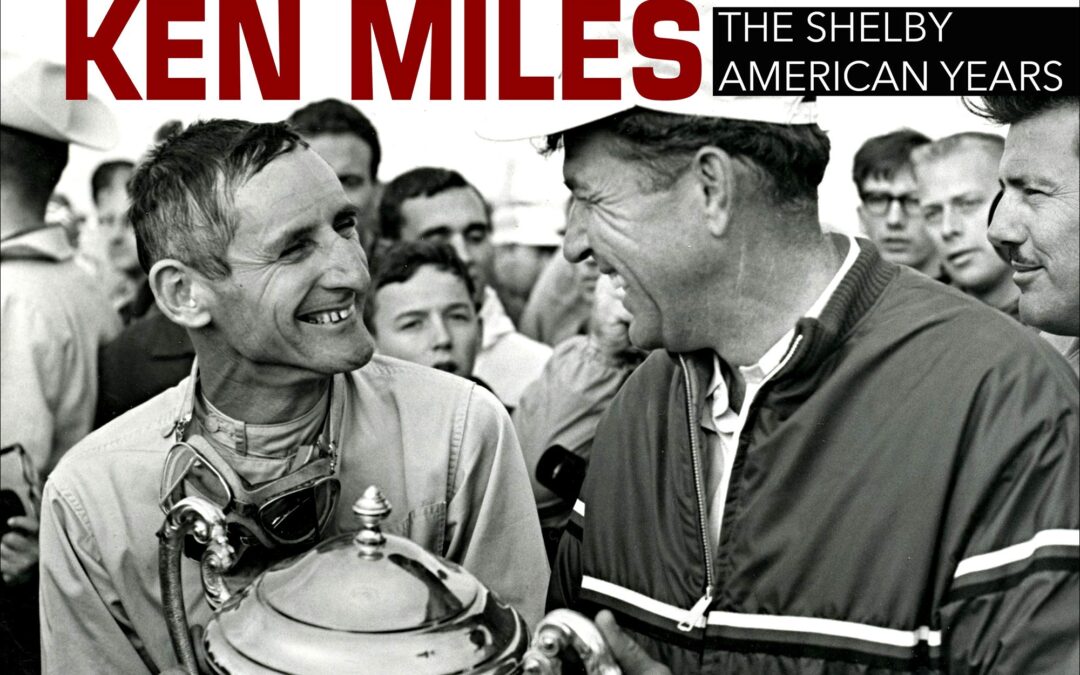
Ken Miles is one of the most famous sports car racers in history, and his time at Shelby American was the pinnacle of his career.
Ride shotgun with Ken Miles through the twists and turns of Sebring, Laguna Seca, Riverside, and Le Mans as seen through the lens of Shelby American photographer Dave Friedman!
The hiring of Ken Miles by Carroll Shelby in February 1963 initiated arguably the greatest pairing of driver/owner partnerships in the history of motorsports. Not only did Shelby hire Competition Manager Ken Miles as an accomplished road racer but also Miles brought professionalism, innovation, and a keen attribute of being able to surround himself with budding, talented individuals.
The list of race cars that Ken piloted at Shelby American is nearly unrivaled: the Shelby 289 Cobra, 390 Cobra, 427 Cobra, King Cobra, Shelby Daytona, Mustang GT350R, and Ford GT. Ken dominated the 1964 United States Road Racing Championship (USRRC) racing season by winning 8 of 10 races to secure the Manufacturers’ Championship. However, it was at Le Mans where Ken Miles became a worldwide household name.
The robbery that was the 1966 24 Hours of Le Mans is laid out in excruciatingly accurate detail as Ford royalty Carroll Shelby, Carroll Smith, Homer Perry, Leo Beebe, Charlie Agapiou, Bob Negstad, Carroll Smith, and Peter Miles recall the race and the tragedy that followed two months later.
Recapture Ken Miles’s career as told by esteemed Shelby American photographer Dave Friedman in this firsthand account titled Ken Miles: The Shelby American Years!
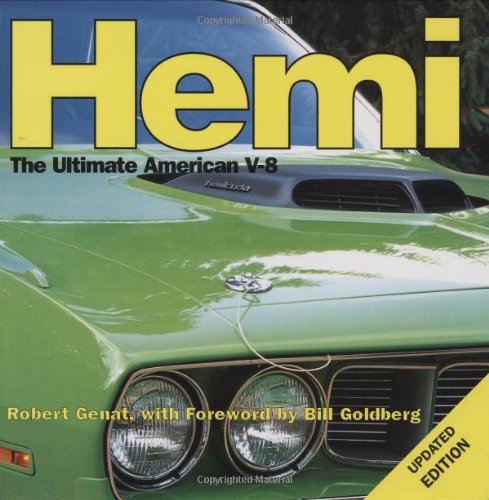
Chrysler’s Hemi is one of the most revered engines in automotive history. Since its introduction in 1951, the Hemi has cast a spell on its owners and fans. Over five decades of production, the Hemi has moved from strength to strength and continues to be the engine of choice for muscle cars everywhere.
Hemi: The Ultimate American V-8 takes you through the evolution of the Hemi, from its initial development through its first installment into Chrysler’s cas, to its heyday in the popular muscle cars of the 1960’s and 1970’s. Robert Genat’s vivid photographs bring these engines and the cars that housed them racing to life. Chock full of facts and fascinating details on this remarkable engine and the muscle cars it powered: Charger, Road Runner, Superbird, Challenger, Barracuda, Super Bee and the rest.

Learn how to maximize your profits and savings when buying and selling collector cars!
The dealership model is an American institution, and auction houses can trace their roots back to the days of dusty cattle sales. Both have remained unchanged. Since the early 2000s, the internet has shaken up these legacy methods of finding, buying, and selling vintage cars, as a global online marketplace that is open to anyone.
CarTech, in conjunction with Patrick Krook of REV! Muscle Cars, introduces a proven process drawn from 20 years of experience building some of the world’s most significant classic car collections. Whether you are a first-time buyer or an established collector, this book shows you how to locate and buy your dream collector car stress free. Get the car you are expecting every time, creating positive cash flow and keeping the hobby fun for years to come.
Inside this book is an easy-to-follow, heavily illustrated step-by-step method to find, evaluate, negotiate, close, fund, and take delivery of a collector car safely over the internet without leaving your living room. It also includes how to avoid costly purchase mistakes, such as overpaying, fakes, or buying someone else’s headache. Better yet, it delves into details about how to always sell out of advantage, minimizing the overall amount you invest as you build your collection over time. Lastly, it provides all the tools you need for buying and selling when you have that person-to-person driveway transaction.
Why spend tens of thousands of dollars on dealership retail markup, auction fees, and failed purchases when you can obtain your dream car, keep more money in your pocket, and spend more quality time enjoying the hobby? How to Buy and Sell Collector Cars takes you from being a novice to a seasoned buyer/seller while you enjoy the adventure of car collecting.
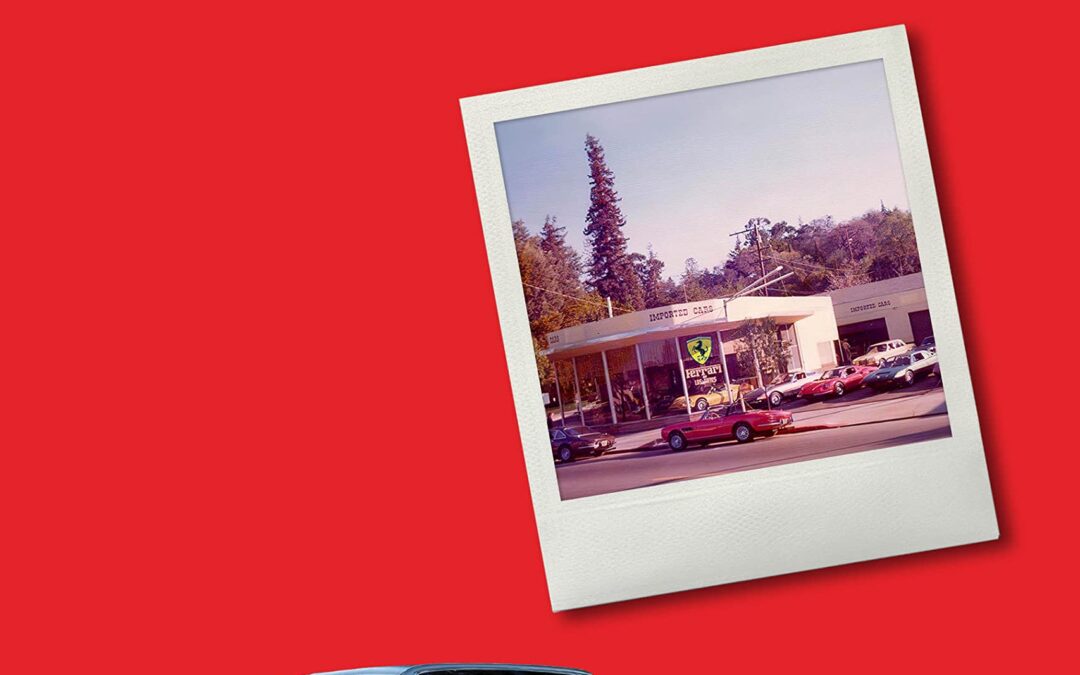
When Ferrari of Los Gatos opened, few people could afford an expensive sports car. In 1976, the average annual income was $12,686, and a new home cost about $48,000. Motorists in California could only buy gas on odd or even-numbered days based on the last digit of their license plate, due to the global oil crisis. Times were tough, and people were hesitant to take chances, especially with a car that cost more than a house.
At the same time, Brian Burnett and his friend Richard Rivoir had the idea of starting a Ferrari dealership. The Dealer is the story of how one dealership, Ferrari of Los Gatos, fueled the rise of the iconic Italian sports car in the U.S. market on its way to becoming the number one Ferrari dealer in North America. Even Enzo Ferrari himself took notice, flying Brian and the other dealers to Italy to show his appreciation for their success. Customers included movie stars, sports celebrities, entertainers, and some with unusual sources of income and a strong desire for a low profile. Along the way, Burnett made friends, enemies, and millions of dollars, only to lose everything in the blink of an eye.
Author Jim Ciardella shows readers a part of Ferrari that no one has even seen, with behind-the-scenes stories as told to him by Richard Rivoir and Brian Burnett, their customers and employees, and other North American dealers who all rode high and eventually burned out on selling fast cars.
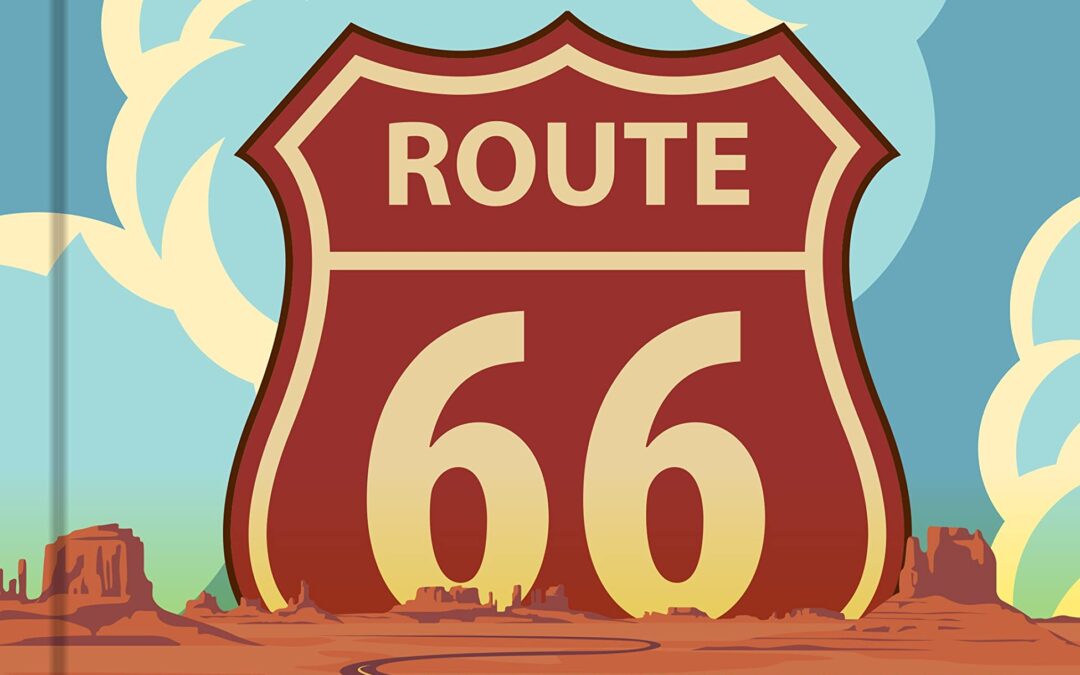
Here We Are . . . on Route 66 explores and celebrates iconic landmarks and cultural touchstones associated with America’s most famous highway—and guides you to some lesser-known gems just off the beaten path.
Spanning nearly 2,500 miles and eight states—Illinois, Missouri, Kansas, Oklahoma, Texas, New Mexico, Arizona, and California—America’s Main Street has given rise to a colorful assortment of roadhouses, motels, greasy spoons, roadside amusements, and breathtaking natural scenery. Acclaimed Route 66 historian Jim Hinckley is your guide to a carefully curated selection of these sites, ranging from the iconic to the revelatory.
Arranged by classic Route 66 topics, each spread gives you a different 66 site or attraction, along with a concise and authoritative history illustrated with colorful photography, evocative historical imagery, and collectibles like postcards, ads, and more. Topics of organization include:
- Towns and Cities
- Natural Wonders
- Roadside Attractions
- Eateries
- Motels and Hotels
- Music, Film, and TV
Hinckley is perhaps the most internationally recognized authority on the subject of America’s Main Street. This collection offers you the stories behind Route 66 icons such as Baxter Springs and Tucumcari, Meramec Caverns, Arroyo Seco Byway, Berghoff’s and the Oatman Hotel, Munger Moss and Wigwam Motel—and dozens more. Hinckley also treats you to a fresh look at lesser known but deserving attractions too.
At nearly a century old, Route 66 remains the embodiment of the classic American highway. Written by an acknowledged authority on the subject, wonderfully illustrated, and presented in a manner that allows you to dip in and out, Here We Are . . . on Route 66 is a must-have for your Route 66 bookshelf.
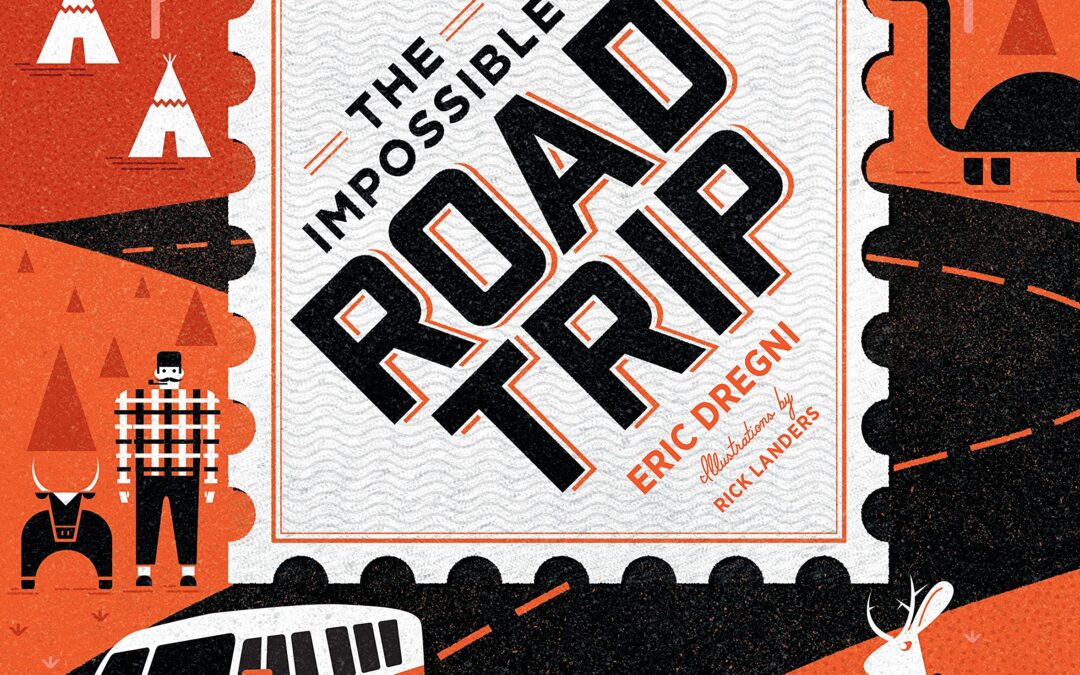
Filled with color photography, entertaining site descriptions and histories, and five unique infographic map illustrations, The Impossible Road Trip is your ultimate look back at America’s most famous—and quirkiest—roadside attractions, past and present.
The great American road trip is back. With its advantages for your health, budget, and the environment, now is the time to plan the road trip you have always dreamed of taking.
Following in the great tradition of the mid-century golden age of car travel, join the new wave of road warriors with a targeted itinerary chosen from the 150 roadside attractions explored in this colorful guide. From famous to quirky and covering all 50 states, author Eric Dregni gives you an unprecedented look at the breadth of roadside attractions in the US, illustrated in part by the photography of architectural critic and photographer John Margolies (1940–2016). Specially commissioned infographic map illustrations capture the spirit of mid-century automobile travel.
Each site depicted is accompanied by a lively and insightful history and color imagery. From autumnal New England to the gothic South, from the homey Midwest to the great expanses of the Desert Southwest, the dizzying heights of the Rocky Mountains, and the breathtaking Pacific Coast, The Impossible Road Trip encompasses it all:
- Neon-shrouded motels
- Mimetic architecture
- Tourist traps
- Roadside sculpture
- And much more
You’ll see sites both famous and esoteric, including the Cardiff Giant in Cooperstown, New York; the five-story Haines Shoe House in York, Pennsylvania; Solomon’s Castle in Florida; the world’s largest fish in Hayward, Wisconsin; one of several Paul Bunyan statues; Bob’s Big Boy in Burbank, California; and so many more.
With The Impossible Road Trip in hand, set out to discover the nation’s oft-overlooked nooks and crannies.
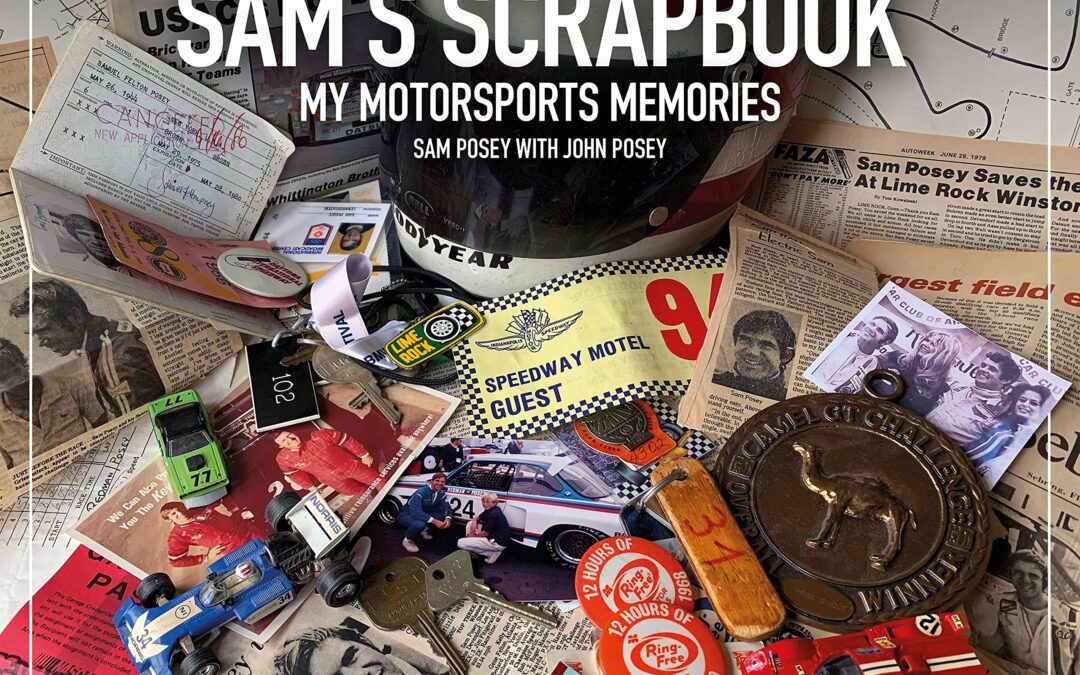
Sam Posey raced a huge variety of sports cars, saloons and open-wheel machines in numerous racing arenas — Can-Am, USRRC, Trans-Am, IMSA, Indy, NASCAR, Formula 5000 and Formula 1 — against rivals and friends such as George Follmer, Parnelli Jones, Mark Donohue, Peter Revson, Dan Gurney, David Hobbs and Brian Redman. Sam’s Scrapbook gives a first-hand account of a romantic era in racing, through pictures no one has seen and stories no one has heard. Running alongside the images, Posey’s commentary is fascinating and thoughtful, and in turns both amusing and emotional.
- Sam’s early days: racing around his mother’s house on a farm in Connecticut against his friend John Whitman.
- The start of his career: driving at Lime Rock, his local track, under the mentorship of John Fitch; a ride as the then-youngest American at Le Mans, with a Bizzarrini in 1966.
- Can-Am: racing against John Surtees, Bruce McLaren and Jim Hall in this famous “anything goes” sports car championship with a car he and Ray Caldwell designed and built.
- Trans-Am: competing in this spectacular saloon series during its golden age, first for Roger Penske and then as a factory driver for Dodge, against George Follmer, Parnelli Jones and Swede Savage.
- Later years at Le Mans: finishing third overall in a Ferrari 512 M with the North American Racing Team (NART) team in 1971; driving the first BMW 3.0 CSL ‘Art Car’ in 1975, featuring a paint scheme by American sculptor Alexander Calder.
- Open-wheel racing: a duel with Dan Gurney in the USAC Championship, finishing fifth at Indy in 1972; two drives for John Surtees in Formula 1; battling his friend and rival David Hobbs on the track and off in Formula 5000.
- Even more variety: three years of off-road adventures in the Baja 1000; rides with the BMW factory team at Sebring and Daytona; and his late career in the IMSA championship with actor Paul Newman and Brian Redman.
This is an unusual and engaging memoir by one of America’s best-loved racing heroes and will appeal to all motorsports enthusiasts.
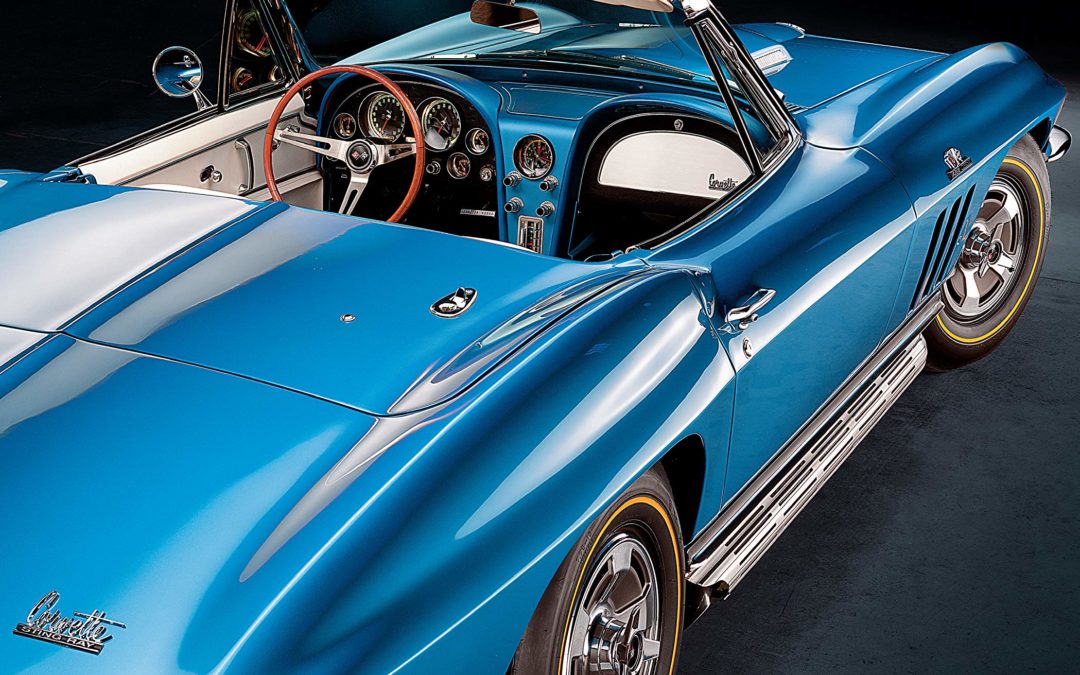
America’s original—and long considered its best—sports car, the Chevrolet Corvette is fast, sexy, sleek, sublime. The legacy of the Corvette is matched only by its beauty, captured here like never before.
Art of the Corvette profiles two dozen Corvettes from all seven generations, beginning with the first 1953 Blue Flame Six Corvette and concluding with the return of an icon, the stunning 2014 Corvette Stingray. Using a unique style of portraiture known as light-painting, acclaimed photographers Randy Leffingwell and Tom Loeser present the most recognizable, unique, and historic Corvettes ever produced. From the chrome-lined grilles of the 1953 Roadster and sexy curves of the first C3s to the aggressive snarl of the 2012 ZR1 and the bold, blunt powerhouse of the 2014 Corvette Stingray, all are presented in breathtaking color and detail. Rare and one-off cars abound as well, like the 1963 Z06 Sting Ray and one of only a handful of 1967 L88 convertibles.
With an authoritative text by Leffingwell, one of the world’s leading Corvette historians, and over 200 stunning photographs, Art of the Corvette presents this landmark of American automotive engineering and design, the Chevrolet Corvette, as never before seen. Some of the vehicles you’ll find inside include:
1953 Corvette – 1963 Sting Ray Z06 coupe – 1966 Sting Ray L72 coupe – 1969 L71 convertible – 1978 Indy Pace Car – 1989 convertible – 1996 Grand Sport coupe – 2003 50th anniversary convertible – 2012 ZR1 coupe – 2014 C7 Stingray coupe
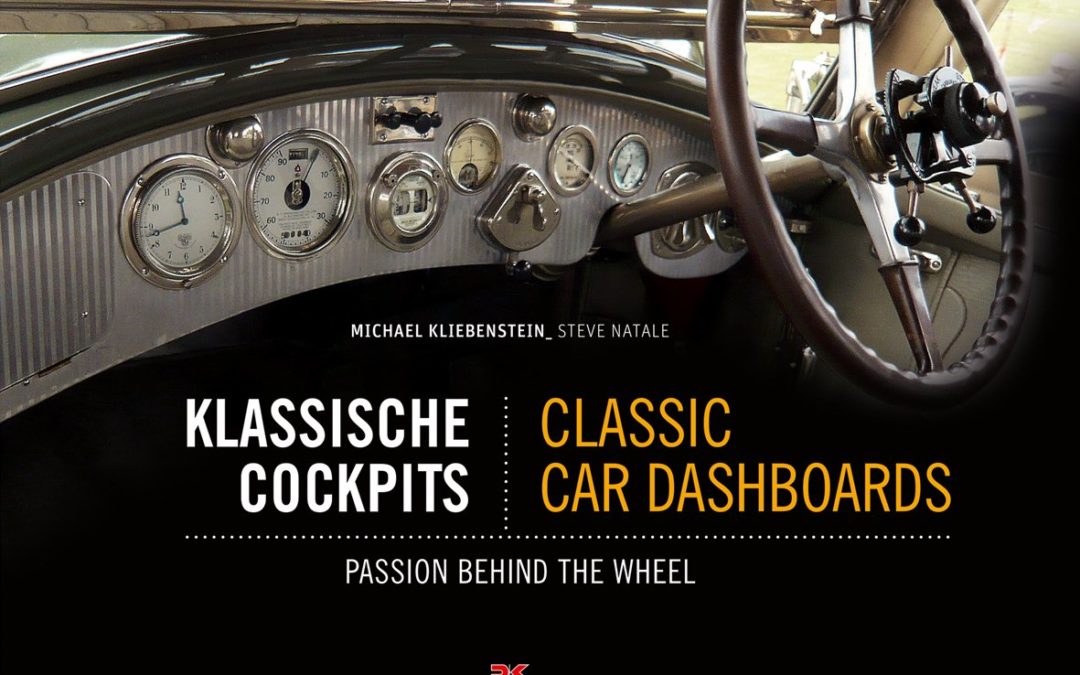
Classic Car Dashboards: Passion Behind The Wheel is a fascinating and nostalgic look into classic and vintage dashboards of the twentieth century. From the most interesting Italian automobiles to the best of British and German examples, and American classics.
This book is about the passion of driving vintage cars, and the challenge of discovering them in hidden places – barns and old warehouses.
Text in English and German.

The Bizarre and Disturbing Adventures of Hitler’s Limousine in America
In 1938, Mercedes-Benz began production of the largest, most luxurious limousine in the world. A machine of frightening power and sinister beauty, the Grosser 770K Model 150 Offener Tourenwagen was 20 feet long, seven feet wide, and tipped the scales at 5 tons. Its supercharged, 230-horsepower engine propelled the beast to speeds over 100 m.p.h. while its occupants reclined on glove-leather seats stuffed with goose down. Armor plated and equipped with hidden compartments for Luger pistols, the 770K was a sumptuous monster with a monstrous patron: Adolph Hitler and the Nazi party.
Deployed mainly for propaganda purposes before the war, the hand-built limousines―in which Hitler rode standing in the front seat―motored through elaborate rallies and appeared in countless newsreels, swiftly becoming the Nazi party’s most durable symbol of wealth and power. Had Hitler not so thoroughly dominated the scene with his own megalomania, his opulent limousine could easily have eclipsed him.
Most of the 770Ks didn’t make it out of the rubble of World War II. But several of them did. And two of them found their way, secretly and separately, to the United States.
In The Devil’s Mercedes, author Robert Klara uncovers the forgotten story of how Americans responded to these rolling relics of fascism on their soil. The limousines made headlines, drew crowds, made fortunes and ruined lives. What never became public was how both of the cars would ultimately become tangled in a web of confusion, mania, and opportunism, fully entwined in a story of mistaken identity.
Nobody knew that the limousine touted as Hitler’s had in fact never belonged to him, while the Mercedes shrugged off as an ordinary staff car―one later abandoned in a warehouse and sold off as government surplus―turned out to be none other than Hitler’s personal automobile.
It would take 40 years, a cast of carnies and millionaires, the United States Army, and the sleuthing efforts of an obscure Canadian librarian to bring the entire truth to light.
As he recounts this remarkable drama, Klara probes the meaning of these haunting hulks and their power to attract, excite and disgust. The limousines’ appearance collided with an American populous celebrating a victory even as it sought to stay a step ahead of the war’s ghosts. Ultimately, The Devil’s Mercedes isn’t only the story of a rare and notorious car, but what that car taught postwar America about itself.
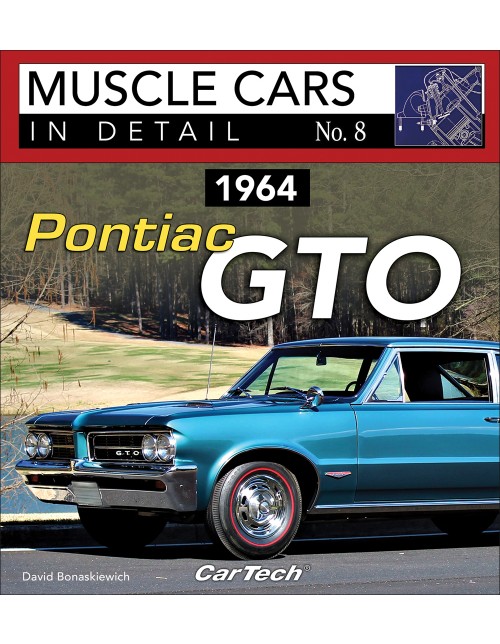
By the mid-1960s, the American automotive market was yearning for faster, more responsive, and sportier cars, and a crew of high-performance enthusiasts at Pontiac recognized this. Large V-8s were commonly installed in full-size cars, but performance was hampered by pure chassis weight. Under the guidance of Bunkie Knudsen, John DeLorean, Bill Collins, and others, Pontiac installed the high-performance 389 V-8 into the nimble and lightweight intermediate-size LeMans chassis. It was a watershed moment for Pontiac; the 1964 GTO delivered astounding performance and created the muscle car blueprint that the Detroit manufacturers followed in the 1960s and 1970s.
This volume in the Muscle Cars In Detail Series delivers a comprehensive review of this trend-setting and historic car. The GTO housed a 389 V-8 engine with a single Carter AFB 4-barrel carburetor, and along with dual exhaust and a standard 3-speed or optional 4-speed manual transmission, it supplied extraordinary performance. To improve traction and handling, the GTO was fitted with stiffer springs, larger-diameter front sway bar, and wider wheels. And to give it panache, the GTO was adorned with distinctive badges and hood scoops. The 1964 GTO is a landmark car, and this book goes well beyond the glossy overview of other books about this car.
All In Detail Series books include an introduction and historical overview, an explanation of the design and concepts involved in creating the car, a look at marketing and promotion, and an in-depth study of all hardware and available options, as well as an examination of where the car is on the market today. Also included is an appendix of paint and option codes, VIN and build-tag decoders, as well as production numbers.

This is the story of the people and events of Projects Mercury and Gemini, told through hundreds of unpublished and rare color and black-and-white photographs. Unlike other publications, which have illustrated the Space Race with well-known and easily accessible images, this history draws from the authors’ private library of more than 125,000 high-resolution photos of the first two U.S. manned space programs from 1961 to 1966.
Collected over a lifetime from public and private sources–including NASA archives, fellow photo collectors, retired NASA and news photographers, and auction houses–the images document American space missions of the Cold War era more comprehensively than ever before. Devoting a chapter to each flight for the first time, the authors also include richly-detailed captions, providing new insight into one of America’s greatest triumphs.Foreword by Lt. Gen. Thomas P. Stafford, USAF (Ret.).
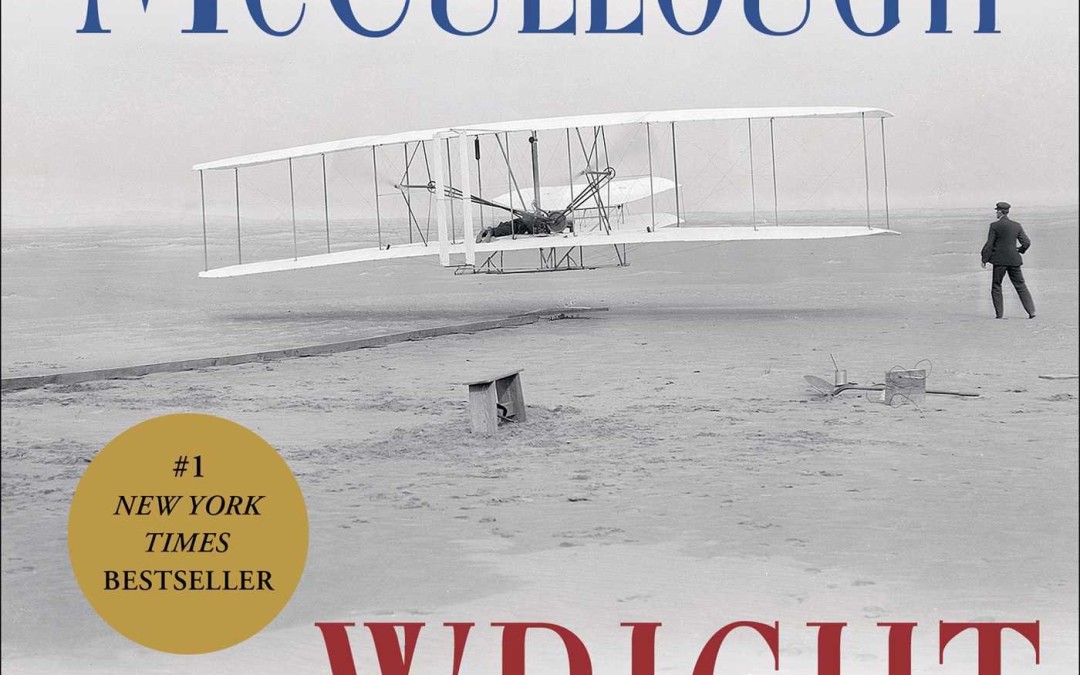
Two-time winner of the Pulitzer Prize David McCullough tells the dramatic story-behind-the-story about the courageous brothers who taught the world how to fly: Wilbur and Orville Wright.
On a winter day in 1903, in the Outer Banks of North Carolina, two unknown brothers from Ohio changed history. But it would take the world some time to believe what had happened: the age of flight had begun, with the first heavier-than-air, powered machine carrying a pilot.
Who were these men and how was it that they achieved what they did?
David McCullough, two-time winner of the Pulitzer Prize, tells the surprising, profoundly American story of Wilbur and Orville Wright.
Far more than a couple of unschooled Dayton bicycle mechanics who happened to hit on success, they were men of exceptional courage and determination, and of far-ranging intellectual interests and ceaseless curiosity, much of which they attributed to their upbringing. The house they lived in had no electricity or indoor plumbing, but there were books aplenty, supplied mainly by their preacher father, and they never stopped reading.
When they worked together, no problem seemed to be insurmountable. Wilbur was unquestionably a genius. Orville had such mechanical ingenuity as few had ever seen. That they had no more than a public high school education, little money and no contacts in high places, never stopped them in their “mission” to take to the air. Nothing did, not even the self-evident reality that every time they took off in one of their contrivances, they risked being killed.
In this thrilling book, master historian David McCullough draws on the immense riches of the Wright Papers, including private diaries, notebooks, scrapbooks, and more than a thousand letters from private family correspondence to tell the human side of the Wright Brothers’ story, including the little-known contributions of their sister, Katharine, without whom things might well have gone differently for them.

Young Henry Ford is a visual and textual presentation of the first forty years of Henry Ford—an American farm boy who became one of the greatest manufacturers of modern times and profoundly impacted the habits of American life. In Young Henry Ford, Sidney Olson dispels some of the myths attached to this automobile legend, going beyond the Henry Ford of mass production and the five-dollar day, and offers a more intimate understanding of Henry Ford and the time he lived in. Through hundreds of restored photographs, including some of Ford’s own taken with his first camera, Young Henry Ford revisits an America now gone—of long days on the farm, travel by horse and buggy, and one-room schoolhouses. Some of the rare illustrations include the first picture of Henry Ford, photos from Edsel’s childhood, snapshots of the interior and exterior of the Ford homestead, Clara and Henry’s wedding invitation, and photos of the early stages of the first automobile.
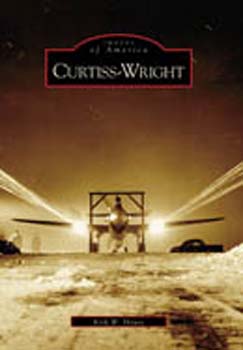
The oldest names in aviation joined forces in 1929, when Wright Aeronautical and Curtiss Aeroplane formed the giant Curtiss-Wright Corporation. Curtiss airplanes were already “the best things with wings,” while Charles Lawrance had made Wright powerplants the leader in American radial engines. Aviation founding father Glenn Curtiss, along with superstars Charles A. Lindbergh, Jimmy Doolittle, Admiral Byrd, and “Wrong-Way” Corrigan, all blazed skytrails with Wright engines and Curtiss wings. Tiny Sparrowhawk biplane fighters flew from airborne dirigibles. Huge factories poured out war birds in tens of thousands for World War II. Pilots flew them everywhere, from the African desert to Alaskan ice, South Sea islands, and even the Taj Mahal. Relive those days when women, old men, and teenagers kept the factories roaring, and follow Curtiss-Wright clear into the 21st century.

Not simply a storage unit or holding space for cars, the garage is reconceived in this innovative design book as a “flex” space for family members that can be clean, organized, and functional (and still house cars). Wall organizers, garage cabinets, and an ergonomically designed workbench are among the suggestions described and illustrated through a case study of how one family reinvented their garage from wall to wall and floor to ceiling. Creative ideas for making the garage into a multipurpose room include placing a television on a wall swivel and moving the treadmill into the garage to create a family gym. Feng shui tips, an overview of garage-design trends over the past 100 years, and speculations about how garages will look in the year 2020 provide a revealing perspective on the importance of transforming the dark, dingy cavern in American homes into a bright, desirable living space.
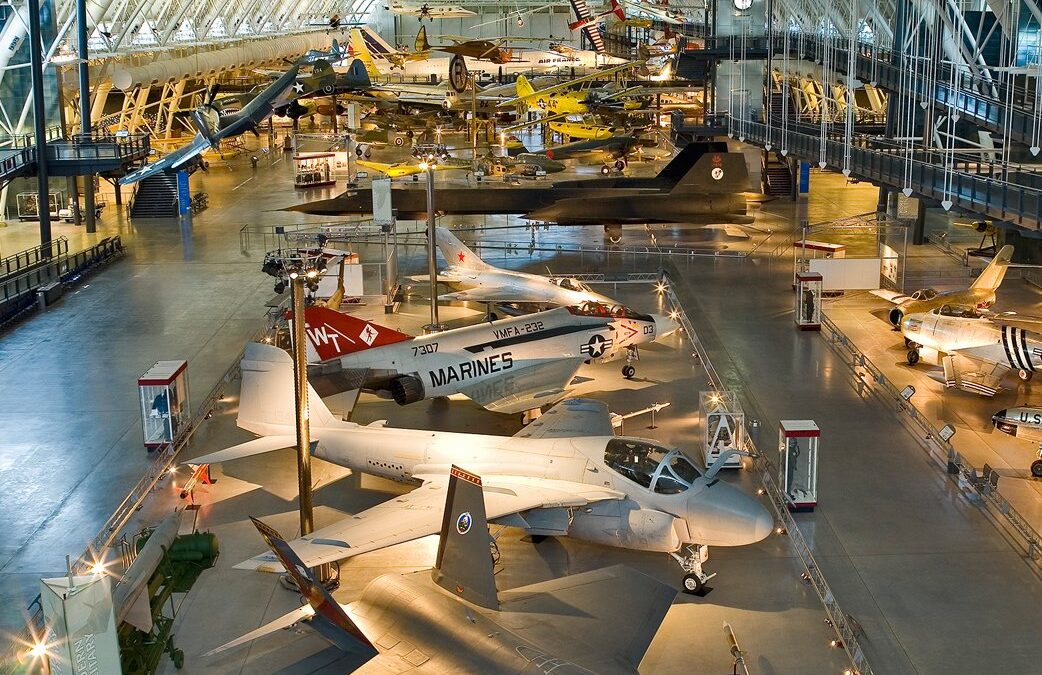
Americans have always had a fascination with flight. In 1896, man’s first man-made aircraft left the ground… if just for seconds. Over the years followed such headliner successes as the Wright Brothers (1903), Charles Lindbergh (1927), Amelia Earhart (1928), Chuck Yeager (1947) and Neil Armstrong/Buzz Aldrin (1969). By the early 1940s and World War II, it was clear that air power would play a decisive role in winning the struggle. War demands pushed aircraft technology and design ahead at a dizzying pace, quickly going further and faster than ever thought possible and providing a treasure trove of legacy aircraft. A new dream of flight began emerging in the early ’60s, beyond the birds and clouds, to visit a world beyond our own. The U.S. and the Soviet Union engaged in a race to the moon, generating huge advances in science, medicine and technology. The Smithsonian Institution’s National Air and Space Museum (established in 1946), also known as America’s Hangar, houses over 300,000 square-feet of aircraft and is the world’s most visited museum. It has preserved and displays many of the world’s most renowned historic aircraft. From the first airplane, commercial aircraft and spacecraft to take an American into orbit, Smithsonian Channel takes you on a personal tour of the collections of the National Air and Space Museum, chronicling the first century of flight.






















